Introduction
The Dolphin Pose, also known as Ardha Pincha Mayurasana, is a strengthening and balancing yoga pose that builds endurance and flexibility in the body.
It is a variation of the more advanced Downward Dog pose and is often used to prepare for forearm stands and other inversions.
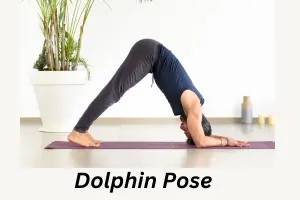
Dolphin Pose targets the upper body, especially the shoulders, arms, and core, while also stretching the hamstrings, calves, and arches of the feet.
This pose provides an excellent foundation for more advanced poses by improving alignment, core stability, and shoulder strength.
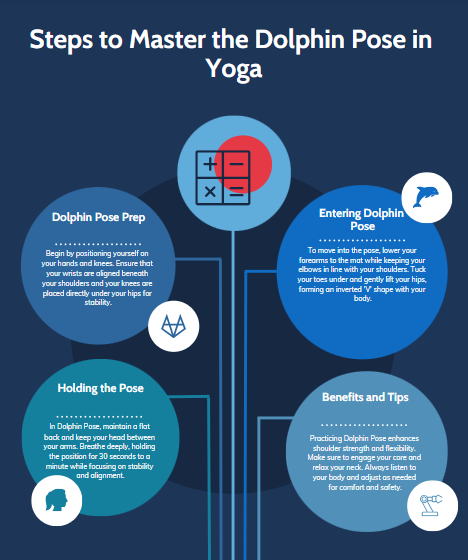
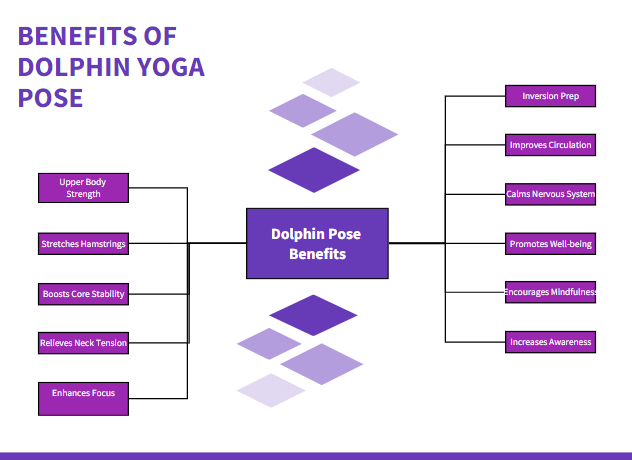
Steps to Perform Dolphin Pose
- Start in Tabletop Position:
Begin on all fours, with your hands under your shoulders and knees under your hips. Keep your spine neutral and engage your core muscles. - Move into Forearm Plank:
Lower your forearms to the ground, ensuring that your elbows are directly under your shoulders. Your forearms should be parallel to each other, with your palms pressing firmly into the mat. Engage your core to stabilize your body. - Tuck Your Toes Under and Lift Your Hips:
Press into your forearms and lift your hips toward the ceiling, creating an inverted “V” shape with your body. Straighten your legs as much as possible while keeping a slight bend in the knees if necessary. Your head should rest between your arms, and your gaze should be toward your feet. - Lengthen Through the Spine and Engage the Core:
Actively press your forearms into the mat to lift your upper body and lengthen through your spine. Draw your belly button toward your spine to engage your core muscles. Keep your shoulder blades drawn away from your ears, creating space in your neck. - Hold the Pose:
Stay in Dolphin Pose for 5-10 breaths, focusing on maintaining stability in your core and shoulders. Breathe deeply and evenly as you hold the pose. If you feel comfortable, you can gradually increase the duration of your hold over time. - Release the Pose:
To come out of the pose, gently lower your knees back to the mat and return to the tabletop position. You can also rest in Child’s Pose to relax your shoulders and back.
Benefits of Dolphin Yoga Pose
- Strengthens the Upper Body:
Dolphin Pose requires significant engagement of the shoulders, arms, and upper back muscles. It builds strength and endurance in the upper body, which can help prepare for more advanced poses like headstands and forearm stands. - Stretches the Hamstrings and Calves:
While holding Dolphin Pose, the legs are engaged, providing a deep stretch for the hamstrings and calves. This can help improve flexibility in the lower body and relieve tightness in the legs. - Improves Core Stability:
Dolphin Pose engages the core muscles, including the abdominals and lower back, to maintain balance and stability. Regular practice of this pose can enhance overall core strength and improve posture. - Relieves Tension in the Neck and Shoulders:
Dolphin Pose helps release tension in the neck and shoulders, especially when the upper body is aligned properly. The pose encourages proper shoulder alignment and can alleviate discomfort caused by poor posture or stress. - Enhances Focus and Concentration:
By focusing on the alignment and balance required for Dolphin Pose, practitioners can improve their mental concentration and focus. The pose requires mindfulness to maintain stability, making it a valuable part of a yoga routine for mental clarity. - Prepares for Inversions:
Dolphin Pose is an excellent preparatory pose for more advanced inversions like headstands and forearm stands. It strengthens the arms, shoulders, and core while helping practitioners become comfortable with weight-bearing on the forearms. - Improves Circulation:
Like other inverted poses, Dolphin Pose encourages blood flow to the brain, which can improve circulation and provide a boost of energy. This increased blood flow can help alleviate fatigue and promote mental alertness. - Calms the Nervous System:
Dolphin Pose has a calming effect on the nervous system, helping to reduce stress and anxiety. The deep breathing and focus required for the pose promote relaxation and mental clarity.
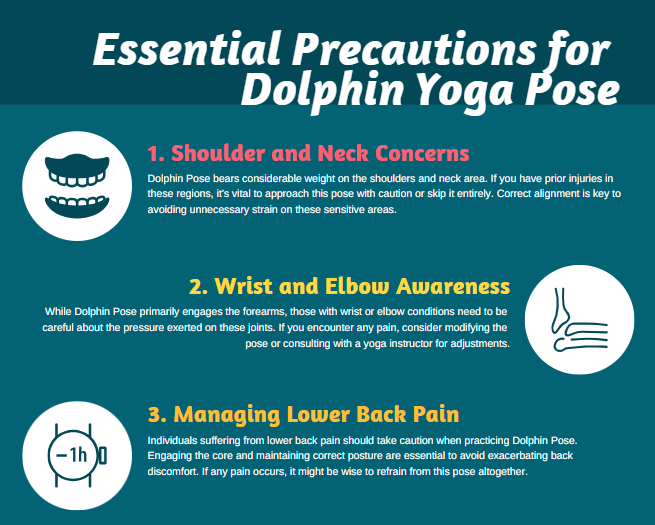
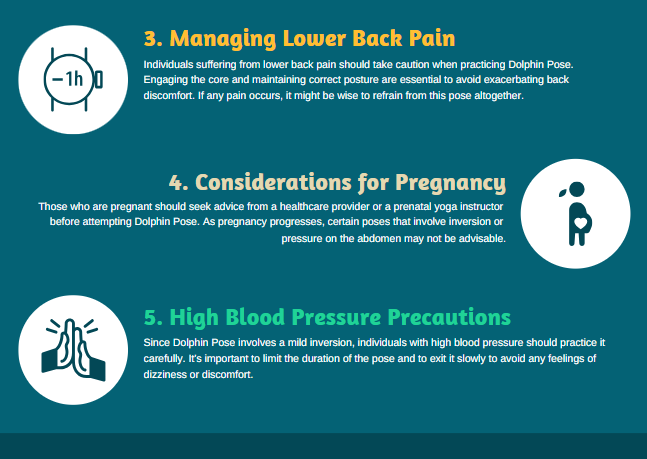
Precautions and Contraindications for Dolphin Yoga Pose
- Shoulder or Neck Injuries:
Dolphin yoga places a significant amount of weight on the shoulders and neck. If you have a history of shoulder or neck injuries, it’s essential to practice this pose with caution or avoid it altogether. Always ensure proper alignment to prevent strain on these areas. - Wrist or Elbow Issues:
Although Dolphin Pose is performed on the forearms, individuals with wrist or elbow issues should be mindful of how much pressure they place on these joints. If discomfort arises, it’s best to modify the pose or seek guidance from a yoga instructor. - Lower Back Pain:
Practitioners with lower back pain should be cautious while performing Dolphin yoga. Engaging the core muscles and maintaining proper alignment are crucial to preventing strain on the lower back. If you experience discomfort, it may be best to avoid the pose. - Pregnancy:
Pregnant women should consult a healthcare provider or prenatal yoga instructor before practicing Dolphin Pose. As the pregnancy progresses, inversions and poses that place pressure on the abdomen may not be appropriate. - High Blood Pressure:
Since Dolphin Pose is a mild inversion, individuals with high blood pressure should practice it with caution. It’s important to avoid holding the pose for too long and to come out of the pose slowly to avoid dizziness or discomfort. - Vertigo or Balance Issues:
If you experience vertigo or balance issues, be cautious when practicing Dolphin Pose, as the inverted nature of the pose can sometimes exacerbate these conditions. Always listen to your body and come out of the pose if you feel unsteady.
Conclusion
- Dolphin Pose or Ardha Pincha Mayurasana, is a powerful and versatile yoga pose that offers numerous benefits for both the body and mind.
- By strengthening the shoulders, arms, and core, while simultaneously stretching the hamstrings and calves, this pose helps build a strong foundation for more advanced yoga poses.
- It also improves posture, balance, and mental focus, making it an essential addition to any yoga practice.
- Whether you are preparing for more challenging inversions or simply looking to enhance your flexibility and strength, Dolphin Pose can be a valuable tool in your yoga journey.
- However, it’s important to practice with proper alignment and mindfulness to avoid injury, especially if you have any pre-existing conditions related to the shoulders, neck or back.
- By incorporating Dolphin Pose into your regular practice, you can build endurance, improve body awareness, and experience the calming effects of this powerful yoga pose.
- As with all yoga poses, remember to listen to your body and make adjustments as needed to ensure a safe and beneficial practice.
